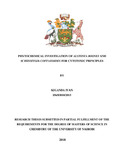| dc.description.abstract | The air dried and ground stem bark and root bark of Alstonia boonei were extracted, separately, with CH2Cl2/MeOH (1:1) by cold percolation. After which, the crude extract of the stem bark was subjected to a combination of chromatographic separation which resulted in the isolation of two terpenes: lupeol acetate (101) and cycloeucalenol (104), a steroid: stigmasterol, a xanthone: lichexanthone (103) and an alkaloid: phenanthridine-6(5H)-one (105). Similarly, the root bark extract resulted into isolation of three triterpenes: 101, 104 and lupeol (106), a steroid: β-sitosterol and an alkaloid: Echitamine (108). Chromatographic separation of the leaf extract of Schizozygia coffaeoides resulted into isolation of stigmasterol, three alkaloids: schizozygine (95), isoschizozygaline (99) and 6,7-dehydro-19β-hydroxyschizozygine (96) and two anthraquinones: cassamin A (97) and cassamin B (98). Compounds 104 and 105 are hereby reported for the first time from Apocynaceae family. All of the compounds structures where elucidated using various spectroscopic/spectrometric techniques; proton and 13C NMR, 1H-1H COSY, HSQC, NOESY, HMBC, ORD and MS.
The crude extract of the root bark from Alstonia boonei exhibited good cytotoxic activity against HepG2 liver cancer cells (IC50 = 12.8 μg/ml) but was toxic to the LO2 normal liver cells (IC50 = 1.19 μg/ml). The crude extract was also toxic to the BEAS-2B normal lung cells but inactive against the A549 human lung cancer cells. Similarly, the crude extract of the stem bark of Alstonia boonei was toxic to the normal cells from both the lung and the liver but not active against the respective cancerous cells. Lupeol was inactive against the A549 cancer cells but toxic to BEAS-2B normal lung cells (IC50 = 0.71 μM). Furthermore, lupeol was very active HepG2 liver cancerous cells (IC50 = 1.65 μM) cells but highly toxic against LO2 normal liver cells (IC50 = <0.1 μM).
vi
Treatment of schizozygine (95) with boron tribromide in an inert atmosphere at -18 oC led to cleavage of the methylenedioxy group leading to the formation the Schizozygine derivative (110) with 29% yield...................................................................................................................................................................................................................................................................................................................................................................................................................................................................................................................................................... | en_US |



